
views
X
Expert Source
Aaron BernardFish & Aquarium Specialist
Expert Interview. 17 July 2020.
You can mix saltwater for your aquarium by getting the necessary supplies, blending the salt and water, and checking the water conditions.
Purchasing Necessary Supplies

Buy a high quality sea salt mix. Fish supply stores offer two ways to get saltwater for your aquarium. One is by pre-made saltwater or getting a synthetic sea salt mix that you blend into the water. If you plan to mix your own saltwater, make sure you purchase the pre-made saltwater solution that you add to water that you supply. Get a dry synthetic saltwater mix. These generally come in tubs of 10 or 22 kilograms or 22 or 48 pounds. You'll need a larger container for bigger aquariums and a smaller tub for smaller aquariums. Keep in mind that even if you have extra, you can use the product to mix future batches of saltwater. Make sure you use a quality, reputable synthetic sea salt mix such as Instant Ocean or Reef Crystals. It's important to use a salt mix specific for your aquarium. If needed, discuss your needs with a professional in the store.
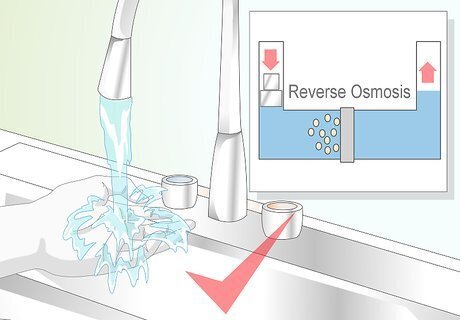
Decide on your water source. Just as your sea salt mix is important, so is the water for the saltwater aquarium. You can use tap water for a fish-only aquarium but need a different water source for reef aquariums. It is ideal to use a good reverse osmosis and/or deionized water (RO/ DI) for fish-only and reef aquariums. Be aware that you should only use tap water if its quality is excellent. It should be free of petroleum, organic compounds such as animal manure, or other chemicals introduced by humans' activities. You'll also need to dechlorinate and dechlorinate tap water before you blend it with the sea salt mixture. You can get products that remove chlorine and chloramines, such as Dr.Tim's Aquatics Aqua Cleanse, at fish supply and some pet stores. Purchase RO/ DI water at a fish or pet supply store. If you are interested, you can also purchase a system that produces RO/ DI water.
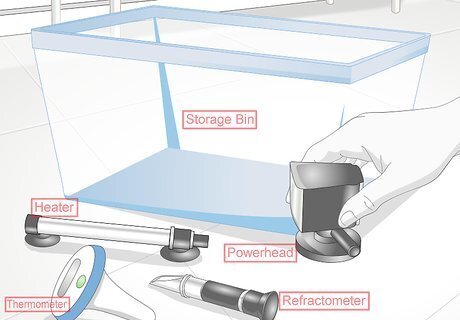
Gather additional supplies. Water and a sea salt mixture are the most important elements of blending saltwater for your aquarium. You'll need a few more supplies to ensure that the aquarium is safe for your fish and/ or corals. Make sure you have the following supplies before you start mixing your saltwater: Clean container, preferably food grade Submersible aquarium heater Floating or battery-powered thermometer Small submersible powerhead or pump for water circulation Refractometer or hydrometer for measuring specific gravity/ salinity, which is how salty the water is Stirring tool or a small water pump for mixing
Blending the Salt and Water
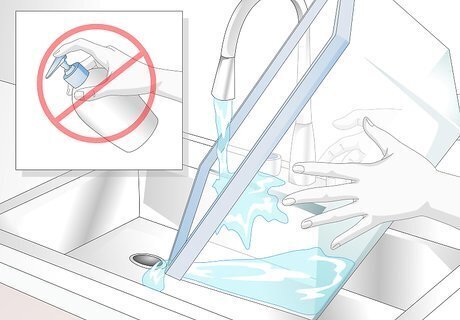
Rinse the container. Before you fill your container with the water, make sure to rinse it with tap water. This can ensure there are no substances in the container that could contaminate your saltwater. Avoid using any detergent when you rinse the container. These can cause harm to the life in your aquarium. When you're done, place the container next to your aquarium so it is easier to fill or refill the water.
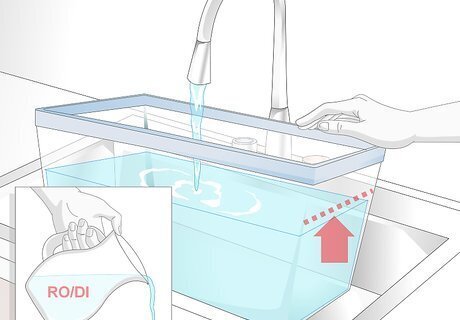
Fill the container with water. Figure out how much water you need in your aquarium, which you can do by checking its size. Fill the container with either tap or RO/DI water in the amount that will work for your aquarium. Avoid filling the container to the top because the salt mix will displace some of the water. Then fill the aquarium with enough of the mixed water to leave room for things such as splashing from the fish, turbulence from the filter, and other animals like snails, which lay their eggs on the top of the water.
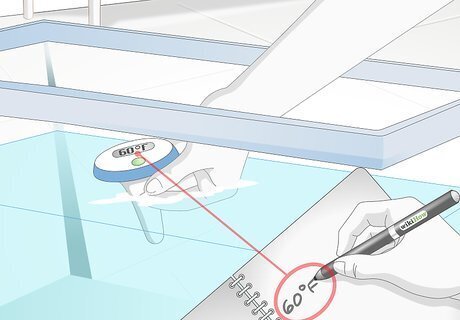
Insert the thermometer in the container. Add your thermometer to the mixing container in a place where you can easily monitor it. This will help ensure that the temperature in the mixing container is the same as in your aquarium, which can also keep your fish and coral healthy. Measure the temperature of your aquarium before putting it in the mixing container. Note the aquarium temperature on a piece of paper so that you don't forget it.

Position the powerhead and heater in the container. Set the powerhead and the heater near the bottom of your mixing container. This can help dissolve the salt more quickly so that you can put it in the aquarium. Make sure the heater temperature is set to the same level as the one currently in your aquarium. The target temperatures you should have are: 72-80 degrees Fahrenheit for fish-only tanks, and 75-78 degrees Fahrenheit for those with reefs. Look to see that the powerhead is creating some turbulence at the water's surface to maximize gas exchange. If it is not, reposition the powerhead until you see light turbulence at the surface.

Add the sea salt mixture. Now that the water is in the mixing container, it's time to add the sea salt. It's important to read the packaging instructions before you add the mixture so that you don't add too much water. Slowly add the salt mixture to your water as you stir it. Note the manufacturers' instructions. They will direct you to use a certain number of pounds of sea salt mixture per gallon of water. You want to ultimately aim for a specific gravity of about 1.025 or a salinity of 35ppt. Add the sea salt mixture in three separate batches. Put in the first batch and stir until it dissolves completely. Then you can add the second batch and blend until the salt dissolves. Finish by adding the third batch of sea salt and mix it until it completely dissolves.
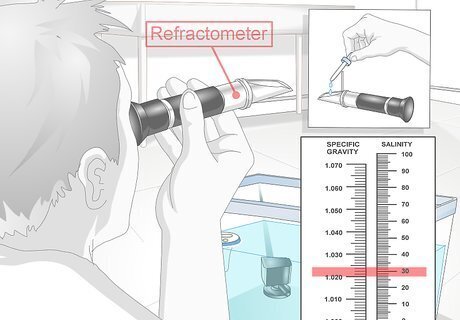
Test the specific gravity. Once you've added the three batches of sea salt mixture, it's important to test the specific gravity of the water with the hydrometer or refractometer. This will let you know if you've added too much or too little sea salt mixture. Watch for the salinity/ specific gravity to be between the levels of 1.020 and 1.024. If the level is below 1.020, add more salt until you reach the desired specific gravity. If the level is above 1.024, add more water until you reach the desired specific gravity. To be safe, double check the salinity test.
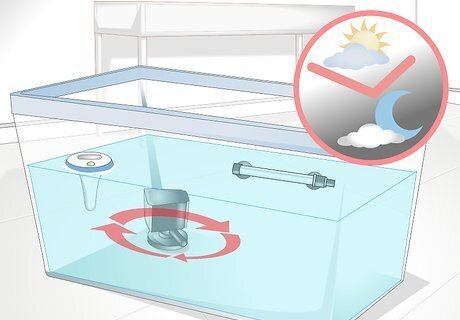
Let the saltwater sit overnight. Before you add the saltwater to your aquarium, allow it to sit at least 24 hours. This can ensure that the salt is completely mixed into the water and that the water achieves proper oxygen/ carbon dioxide equilibrium. Leave the powerhead in the container so that it can aerate the water properly. This will help the water achieve proper oxygen/ carbon dioxide equilibrium. You should also leave the thermometer in the container.
Checking Your Saltwater Conditions

Monitor the specific gravity. After you've allowed the saltwater mixture for at least 24 hours, it's important to check the salinity/ specific gravity again. This can alert you to potential imbalances that need adjusted. Adjust the specific gravity levels until they reach the optimal level of 1.020 to 1.024. Add more salt if they are too low and more water if they are too high.
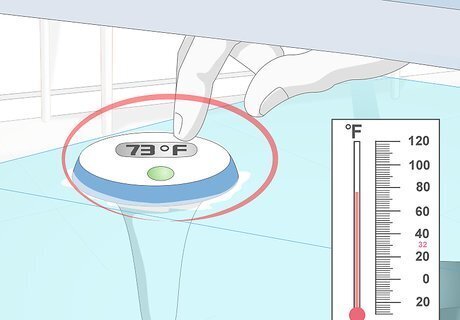
Measure your aquarium's temperature. Just as salinity is important to the wellbeing of your fish, so is the water temperature. Once you've tested and adjusted the specific gravity, check the water temperature. It should be the same temperature as the water in your aquarium. Keep heating it if the temperature is too low. Remove the heater and keep checking the temperature until it reaches the optimal range of 72-75 degrees Fahrenheit for fish only and 75-78 degrees Fahrenheit for reef systems. Be aware that adding salt water at a different temperature than your aquarium will cause a change in temperature for your aquarium. This could harm the health of your fish.
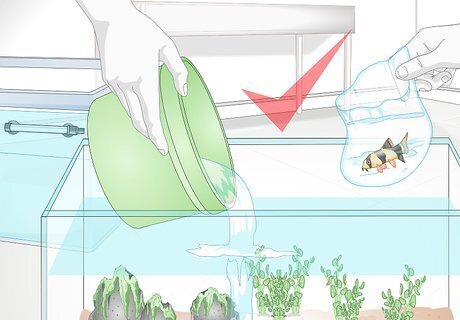
Pour the saltwater mixture into your tank. When all of the water levels are optimal, you can begin adding the new saltwater to the aquarium. Make sure to add the water slowly so that it doesn't shock any fish or other life in the aquarium. Keep checking the temperature and salinity of the water to ensure the levels remain stable. Add your fish back to the aquarium once it is filled to the appropriate level. You may want to consider double checking the salinity and temperature before adding the fish if you are concerned.















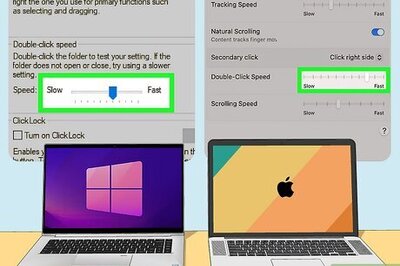



Comments
0 comment